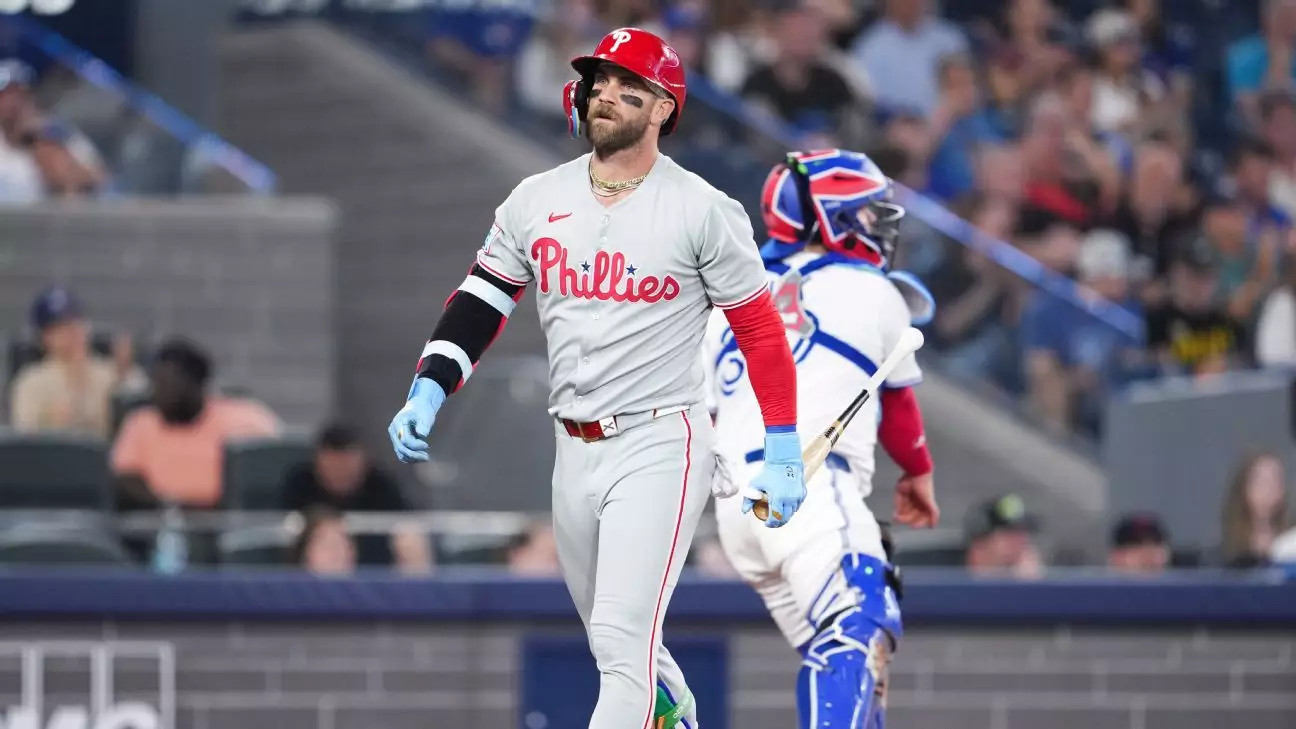Bryce Harper’s return to the Philadelphia Phillies lineup after nearly a month away encapsulates both perseverance and cautious optimism. The right wrist inflammation that sidelined him—an injury stretching back to last season—had plateaued in terms of improvement, pushing Harper and the team toward a critical decision: continue resting or step back into action. Harper’s acknowledgment that his wrist had reached “as good as it gets” signals a pragmatic acceptance of ongoing discomfort, a reality that veteran athletes often face but rarely discuss openly. Rather than waiting for a miraculous overnight recovery, Harper chose to trust his body’s stability and contribute as best he can.
This is not simply a story of physical healing but one of mental fortitude. To bear pain throughout the previous season, hitting 30 home runs and powering his team to an NL East division crown, speaks volumes about Harper’s commitment. Likewise, managing a .258 batting average with nine homers through 57 games this season underlines how he’s balanced performance and injury management. Harper’s approach reminds us that in professional sports, resilience is often as critical as raw talent.
Choosing to Play: Risk Versus Reward
Harper’s decision to return to starting at first base and bat third against the Padres is a calculated gamble. Manager Rob Thomson’s caution—labeling Harper’s status as day-to-day and a function of how the wrist “holds up”—reflects awareness of the fragile situation. Opting to play when the injury has plateaued implies weighing the potential risks of aggravating the wrist against the undeniable need for Harper’s offensive firepower.
The Phillies’ record without Harper, slightly below .500 at 13-14, showcases how much they miss his presence. The team’s sustained lead in the NL East hints at its depth but also underscores the marginal difference Harper’s return could provide, especially as they push into the critical phases of the season. Whether Harper accelerates seamlessly back into form or confronts setbacks, his presence inherently boosts morale and raises the bar for the entire lineup.
Adapting Roles and Team Dynamics
Harper’s situation also provokes questions about evolving roles within the Phillies’ roster. His wrist discomfort offered little variance between batting and throwing, suggesting flexibility but also limitations. The possibility of assigning Harper as a designated hitter demonstrates a strategic pivot to minimize strain while maximizing his offensive contribution. This move would open the door for emerging players like Kyle Schwarber, who has excelled in the DH spot with 25 home runs this season, and rookie Otto Kemp, whose versatility—covering third base and outfield—adds valuable depth.
Kemp’s impressive start since being called up to fill Harper’s void accentuates how the Phillies can balance youth and experience. His 10 RBIs in 20 games hint at a promising future but also the inevitable competition Harper’s return will stir. While Harper anticipates Kemp maintaining a presence in the lineup, the underlying message is clear: performance and adaptability will dictate playing time in this critically important stretch. The Phillies are managing not just injuries but the fine art of roster optimization.
High Stakes in Harper’s Prime Years
Bryce Harper is no ordinary player. Bound to the Phillies by a massive, $330 million, 13-year contract, his performance inherently carries weighty expectations. His leadership during the Phillies’ three consecutive playoff runs, including the 2022 NL Championship Series MVP moment against the Padres, marks him as a cornerstone franchise figure. Recovering and contributing following this wrist setback is not just a personal challenge but a pivotal moment for a team hungry to recapture championship momentum.
The wrist injury, however, is a nagging reminder that even iconic athletes confront vulnerabilities. Harper’s handling of the situation—choosing to play “as is” and focusing on daily physical feedback rather than waiting for perfection—embodies a blend of realism and determination. It showcases how modern athletes balance career longevity against immediate competition demands, often walking a fine line between managing pain and risking further harm.
Bryce Harper’s comeback signifies more than a player rejoining a lineup; it represents a seasoned warrior’s steadfast refusal to be sidelined by adversity, a strategic recalibration by the Phillies, and an evolving narrative of endurance in Major League Baseball.


Leave a Reply